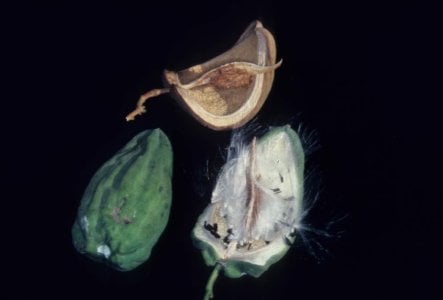Woman narrowly avoids disaster after licking this mysterious fruit in her garden!
- Replies 3
Gardening is often seen as a peaceful and rewarding hobby, especially for those who have more time to enjoy their backyards in their later years.
However, this recent incident serves as a stark reminder that not everything in our gardens is as benign as it seems.
A mother, who also has the responsibility of looking after two young children and pets, made a startling and potentially lethal discovery in her garden.
She noticed an unusual vine entwined around her rose bush, bearing what looked like large fruits.
Drawn in by their somewhat sweet aroma, she did something that many of us might consider harmless—she licked the fruit.

Taking to a social media group in search of answers, she posted photos of the mysterious plant, revealing its yellow seeds.
'Someone please tell me what this is,' she pleaded with her online community.
‘It also bleeds that milky stuff when it’s picked off,’ she added, also mentioning the sweet taste of the mysterious fruit.
‘I have no idea, and need some help, pretty please.’
The post quickly garnered attention, with some suggesting it might be an edible chayote, also known as choko.
However, the consensus soon shifted to a more alarming identification—the plant was a moth vine, a harmful and poisonous weed.
‘Please do not eat this. It is a weed and needs to be disposed of. It is not a choko. Choko has smooth, bright skin, not hairy,’ one commenter suggested.
The moth vine is a fast-growing plant that can smother and kill native vegetation.
It's not just a threat to the environment; it's also dangerous to humans and animals.
‘The leaves and seeds are poisonous,’ Agriculture Professor Daniel Tan declared, confirming that the mysterious fruit is, indeed, a moth vine.
‘The latex sap can cause skin and eye irritation and in some cases, it can cause breathing difficulties.’
According to the Department of Primary Industries, the plant originated from South America and is extensively naturalised and predominantly found in eastern New South Wales and southeastern Queensland.
Additionally, it is considered a weed in regions such as New Zealand, Africa, Europe, and North America.
Each fruit holds as many as 400 seeds, which are carried by wind and water, facilitating the rapid spread of this invasive weed characterised by white or pink flowers.
‘If people find it in their yard, pull it out from the roots, and remove all fruits (and seeds) to prevent seed dispersal,’ Professor Tan advised.
Individuals are advised to refrain from touching the milky sap and should utilise protective gear such as gloves.
In the event of poisoning from the moth vine, if breathing difficulties or unresponsiveness occur, emergency services should be contacted immediately at Triple-0.
If the affected person is conscious, contacting the Poisons Information Centre at 13 11 26 or consulting with a doctor is recommended.
Livestock are also susceptible to poisoning by the plant, which can lead to fatal outcomes, with symptoms including vomiting and impaired balance.
As individuals uncover surprising and potentially hazardous discoveries in their gardens, it's essential to remain vigilant about potential dangers lurking in unexpected places.
This sentiment extends to the critical warning issued regarding the presence of deadly mushrooms, emphasising the importance of exercising caution within our premises.
By staying informed and proactive, particularly regarding potential threats to health and safety, people can better safeguard themselves against unforeseen risks.
 Have you ever encountered a dangerous plant in your garden? How did you deal with it? Share your stories and tips in the comments below.
Have you ever encountered a dangerous plant in your garden? How did you deal with it? Share your stories and tips in the comments below.
However, this recent incident serves as a stark reminder that not everything in our gardens is as benign as it seems.
A mother, who also has the responsibility of looking after two young children and pets, made a startling and potentially lethal discovery in her garden.
She noticed an unusual vine entwined around her rose bush, bearing what looked like large fruits.
Drawn in by their somewhat sweet aroma, she did something that many of us might consider harmless—she licked the fruit.

A woman was almost hospitalised after licking a mysterious fruit in her garden. Credits: NSW Weedwise
Taking to a social media group in search of answers, she posted photos of the mysterious plant, revealing its yellow seeds.
'Someone please tell me what this is,' she pleaded with her online community.
‘It also bleeds that milky stuff when it’s picked off,’ she added, also mentioning the sweet taste of the mysterious fruit.
‘I have no idea, and need some help, pretty please.’
The post quickly garnered attention, with some suggesting it might be an edible chayote, also known as choko.
However, the consensus soon shifted to a more alarming identification—the plant was a moth vine, a harmful and poisonous weed.
‘Please do not eat this. It is a weed and needs to be disposed of. It is not a choko. Choko has smooth, bright skin, not hairy,’ one commenter suggested.
The moth vine is a fast-growing plant that can smother and kill native vegetation.
It's not just a threat to the environment; it's also dangerous to humans and animals.
‘The leaves and seeds are poisonous,’ Agriculture Professor Daniel Tan declared, confirming that the mysterious fruit is, indeed, a moth vine.
‘The latex sap can cause skin and eye irritation and in some cases, it can cause breathing difficulties.’
According to the Department of Primary Industries, the plant originated from South America and is extensively naturalised and predominantly found in eastern New South Wales and southeastern Queensland.
Additionally, it is considered a weed in regions such as New Zealand, Africa, Europe, and North America.
Each fruit holds as many as 400 seeds, which are carried by wind and water, facilitating the rapid spread of this invasive weed characterised by white or pink flowers.
‘If people find it in their yard, pull it out from the roots, and remove all fruits (and seeds) to prevent seed dispersal,’ Professor Tan advised.
Individuals are advised to refrain from touching the milky sap and should utilise protective gear such as gloves.
In the event of poisoning from the moth vine, if breathing difficulties or unresponsiveness occur, emergency services should be contacted immediately at Triple-0.
If the affected person is conscious, contacting the Poisons Information Centre at 13 11 26 or consulting with a doctor is recommended.
Livestock are also susceptible to poisoning by the plant, which can lead to fatal outcomes, with symptoms including vomiting and impaired balance.
As individuals uncover surprising and potentially hazardous discoveries in their gardens, it's essential to remain vigilant about potential dangers lurking in unexpected places.
This sentiment extends to the critical warning issued regarding the presence of deadly mushrooms, emphasising the importance of exercising caution within our premises.
By staying informed and proactive, particularly regarding potential threats to health and safety, people can better safeguard themselves against unforeseen risks.
Key Takeaways
- A Canberra woman narrowly avoided a medical emergency after tasting a poisonous plant in her garden, mistaking it for something edible.
- The plant in question was identified as a moth vine, which has poisonous leaves and seeds, and can cause skin, eye irritation, and breathing difficulties.
- The Department of Primary Industries indicated that the moth vine is a fast-growing, invasive weed common in Eastern NSW and Southeast Queensland, and is harmful to both people and animals.
- People are advised to carefully remove moth vines from their property, including extracting the roots and seeds to prevent further spread, and to call emergency services or the Poisons Information Centre if poisoning occurs.







